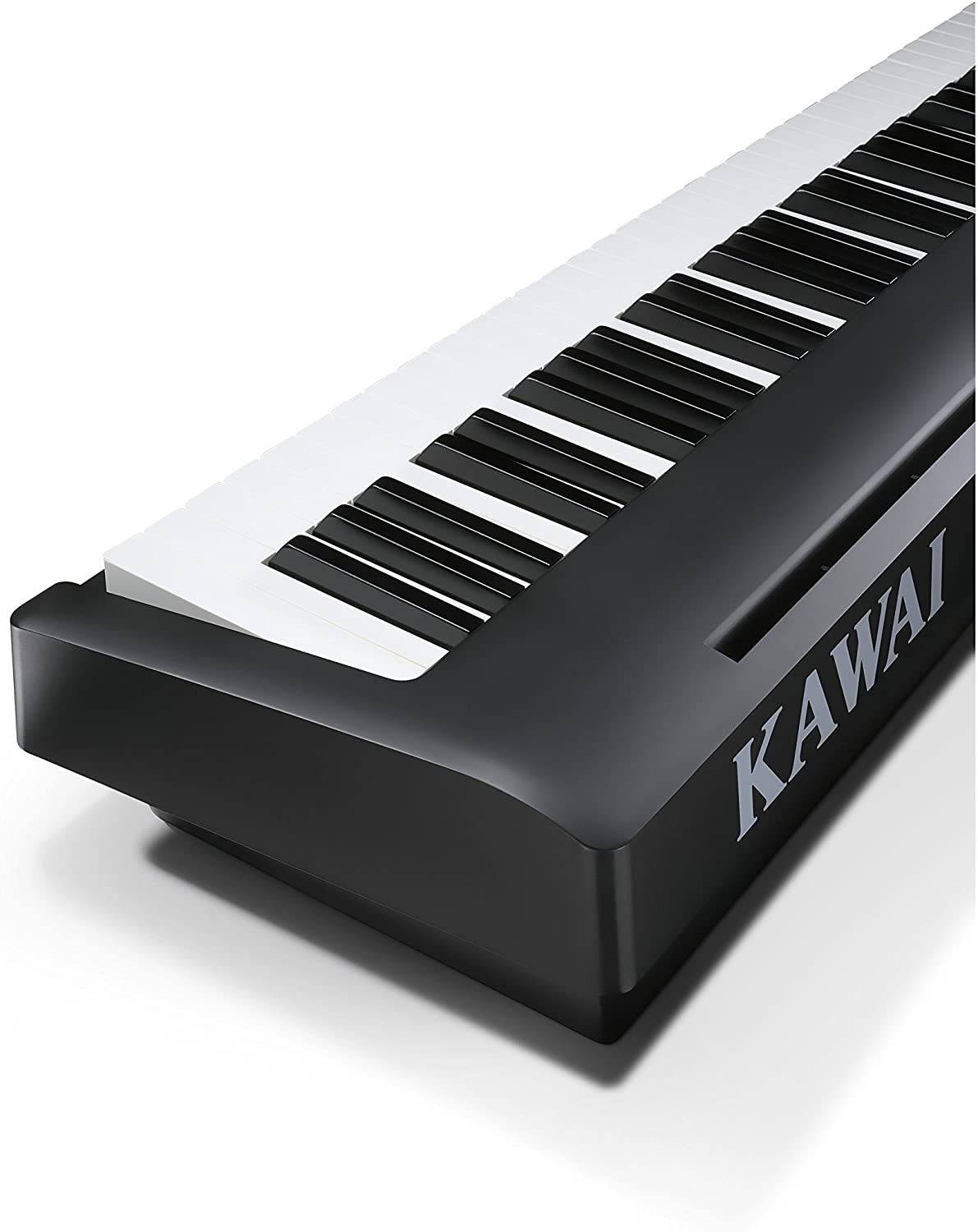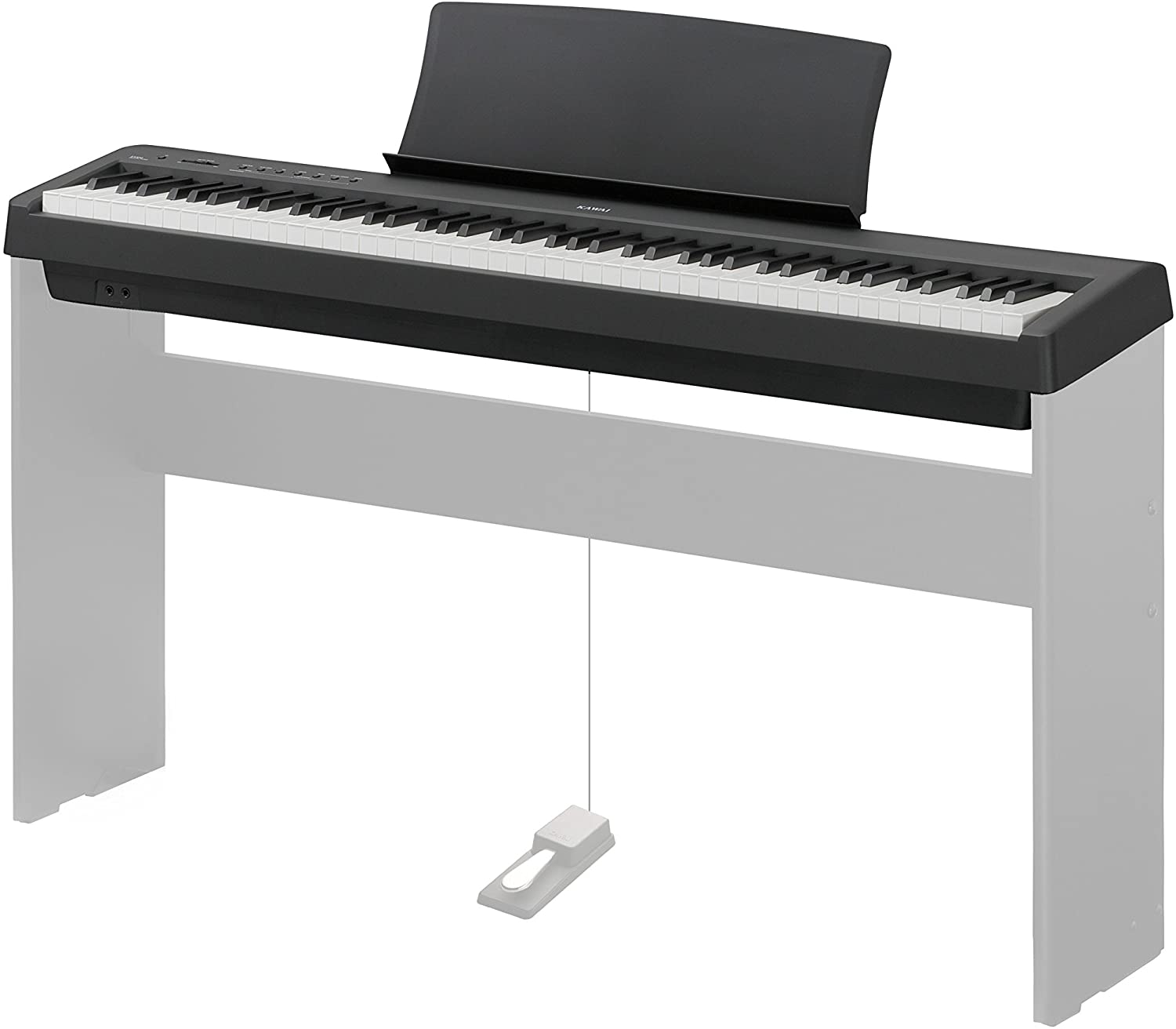







If you want to play the piano but the price of buying one keeps putting you off, opting for a digital piano could be the way to go. We’ll be talking more about what the Kawai ES100 digital piano is and what it has to offer you in this review in order for you to make the right decision for your musical needs.
In this Kawai ES100 review, we’ll discuss how it’s different from other digital pianos as it’s better value for money. You can get the sound of a real piano while having the portability of a digital piano which is great for students who need to practice at home.
| Number of keys | 88 |
|---|---|
| Polyphony | 192-note |
| Sound technology | Harmonic Imaging™ |
| Modes | Dual and Split |
| Internal recorder | 3 Song / 1-Track Recorder, Approximately 15,000 notes memory |
| Speaker system | (8 x 12 cm) x 2, 7 W x 2 |
| Reverb | Room, Small Hall, Concert Hall |
| Settings | Touch Curve, Voicing, Damper Resonance, Damper Noise, Fall-back Noise, Temperament |
| Demo songs | 12 Sound Demo Songs |
| Other functions | Transpose, Table EQ, Tuning, User Memory, Factory Reset, Split Balance, Dual Balance, MIDI Channel, Local Control, Transmit PGM#, Multi-timbral Mode, Auto Power Off, Speakers On/Off |
| Jacks | MIDI (IN/OUT), Damper (for F-10H), Headphone x 2 |
| Size | 51.6 x 11.2 x 5.7 inches |
| Weight | 33 lbs. |
| Warranty | Three years |
The Kawai ES100 can be the right digital piano for you. It not only gives you the feeling of a real piano, but it also sounds like you’re using a real piano. This portable and affordable piano is highly recommended by students and teachers alike.
In this Kawai ES100 review, we’ll be going through all the specifications and details that you need to know about this digital piano you need to consider. There’s no doubt that you’ll find what you’re looking for when it comes to the Kawai ES100, so continue reading to find out more!
Some people may say that a digital piano doesn’t give you the same feeling like a real piano, but this is not the case with the Kawai ES100. Giving you the option of transporting it wherever you need to go, the Kawai ES100 is ideal for when you need to take your musical instrument with you to band practice.
You don’t have to sacrifice your musical standards, especially if you can’t afford a real piano. You can create the complete musical experience with this digital piano as you also have the option of adding the sounds of:
This digital piano is easy to use and will help you improve your musical goals.
The Kawai ES100 has 88 key sampling, which means all of these 88 keys have been individually created from an acoustic grand piano. This will give you that ‘real’ piano sound you’re looking for when practicing your music.
With the Kawai ES100, you can create the musical number you’ve always dreamed of. This should be taken into consideration because most digital pianos that give you this type of performance are usually extremely expensive.
With 192 note polyphony, the Kawai ES100 beats other digital pianos that are in the same price range. This means that the keyboard can produce 192 polyphony notes without increasing the price of the piano, while other pianos in the same price range may only be able to produce 128.
The Kawai ES100 has been created with the intention of creating the sound of a Shigeru piano by using a new sound technology called SK-EX Rendering Trusted Source Kawai Sound Technology Multi-channel sampling captures the sound from different points of the Shigeru Kawai concert grand piano, allowing a broader range of tonal characteristics to be reproduced, and providing a more lively, authentic response to changes in dynamics. kawaius.com . This new sound technology blends the 88-key sampling with the resonance modeling technology.
It’s because of this that you’ll be able to create a complete musical piece with all the bells and whistles provided by Kawai ES100. This technology has captured the different sounds from the SK-EX Shigeru Concert grand piano, which allows you to have a wider range of musical notes and sounds than your ordinary digital piano.
With that being said, because of the newly developed resonance algorithms, you’ll be able to feel as if you’re sitting in a live concert when using the Kawai ES100.
There are two modes on this digital piano: duel and split. This gives you the option of using two different voices/sounds Trusted Source How to Layer Sounds on the Keyboard - dummies Layering or blending two sounds together creates a wonderful, rich sound on the keyboard. Think of the sound of acoustic piano blended with some warm strings; it’s the perfect sound for playing a sensitive pop ballad. Combining a pipe organ with some vocal choir sounds gives you just the right blend for praise and worship music. www.dummies.com at the same time for a more well-rounded sound. For example, you can play an electric piano and a string instrument simultaneously to create a musical masterpiece.
There is a built-in three-note recorder that allows you to record a maximum of 15,000 notes at one time. However, there is no two-track piano recording feature that most other digital pianos have.
There are six different settings on the Kawai ES100, this includes:
On their website, it states that this piano has a three-year part and labor warranty as long as you still have the receipt for proof of payment and the date of purchase. However, it should be noted that the Kawai ES100 will last much longer than three years without needing to use the warranty due to the sturdiness of the product.
It is lightweight and easy to use, and it’s been designed for frequent use making the overall durability extremely high.
You would think that with everything you get with this digital piano that it would cost you a lot of money, but that’s not the case. The Kawai ES100 costs under $1000, which is a steal for what you’re getting.
Whether you’re a student or you’re looking for a new digital piano for your musical hobby, the Kawai ES100 is a great choice. It will not only help you learn with the built-in lessons, but it will help you create something magical in the comfort of your own home and at an affordable cost.
Here is a quick breakdown of the main key features that come with the Kawai ES100 in order to help you decide if it’s the digital piano you’re looking for:
|
PROS |
CONS |
|
|
After reading this Kawai ES100 review, you should now be able to decide if the Kawai ES100 is the right digital piano for you. With all the benefits that come with this digital piano, you really can’t go wrong. You’ll be able to play the music you want as there are plenty of sounds to play with.
You won’t need to worry about using other expensive instruments to make the sound you’re looking for because it has various sounds built into the system!